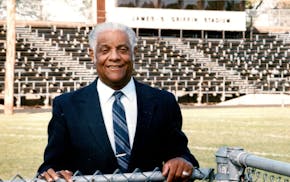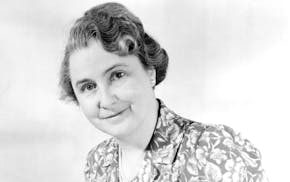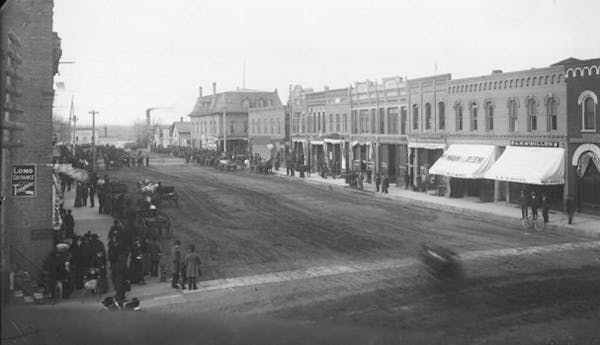Emil Gabbert took a break from his farm chores, stretched out his left arm and snapped a photo of himself 100 years ago — an early selfie that shows him in front of the family barn, fedora balanced back on his ears, near Howard Lake, Minn.
"I suspect it's from around 1918 to 1923, based off his age," said Gabbert's great-grandson, Gunnar Anderson of St. Louis Park. "Cameras, tractors, cars, engines, chemistry. All of these things held a fascination for him."
I ran across Gabbert's century-old selfie while thumbing through Instagram. Anderson, an 18-year-old anthropology student at Luther College in Decorah, Iowa, had sent the image to Historical Leaks, an Instagram account that bills itself as "Your Daily Dose Of History."
The online post has prompted more than 3,200 likes — not bad for an otherwise forgotten farmer from Victor Township, Minn., about 45 minutes west of Minneapolis. Born in Wright County in 1901, Gabbert would have been tickled about resurfacing online 122 years later; Anderson said his great-grandfather was "a technophile, always amazed at new technology."
Emil "was deeply excited for the future and the wonders that technology could bring," Anderson said. "He saw, in his lifetime, the first airplanes fly and men walk upon the moon."
The second youngest of a dozen siblings, Gabbert endured pain and grief while growing up on the farm. At just 2, a horse kicked him in the head, fracturing his skull and leaving him deaf in his left ear.
"He was unconscious for 12 hours, after which he regained consciousness and is doing as well as can be expected at present," the Howard Lake Herald reported in May 1904.
Emil was only 13 when his father, Fred, died of a heart attack at 59. He took over the farm with his brother Louis, becoming "thick as thieves for the rest of their lives," Anderson said. They would stage a recurring prank if either visited the other when he wasn't around.
"All yard decorations, children's toys, wheelbarrows, etc., would be stacked up against the house door," Anderson said. "This was the brothers' way of letting each other know they had come calling, but found no one home."
Their father's death came just as Emil's formal schooling ended with the eighth grade. But he devoutly read magazines such as Popular Mechanics to quench his scientific curiosity.
Blue-eyed with brown hair, Gabbert stood about 5 feet 7 inches tall and weighed 140 pounds. Although he never learned to read music, he was naturally skillful at guitar, harmonica, musical saw and organ.
In the depths of the Great Depression, he married Rosa Ordorff, a schoolteacher from nearby Buffalo, in 1932. He was 30 and she was 22. On their honeymoon to South Dakota, Emil played guitar on the radio show of a local band leader named Lawrence Welk, a friend of an older Gabbert brother.
Rose and Emil raised four children, all of whom attended St. James Lutheran Church in Howard Lake. Emil was active in the church despite an early dustup; at a time when men and women sat in different pews, "he scandalized the congregation by refusing to sit in a different pew from his bride," Anderson said.
Emil didn't care. He'd sit next to his wife for more than 50 years.
"Never afraid to leverage his hearing loss," Anderson said, "he drove his critics to frustration by never quite hearing what they were trying to tell him, unless it was at least partially agreeable to him."
Anderson inherited his "huge passion for history" from his grandmother Donna, who was Emil and Rose's third child. She kept Emil's leather kidney belt, which he used for support while riding the Thor motorcycle he and Louis bought between the World Wars. The belt, along with old photos and stories, was passed down to Anderson.
Among the things he learned: His great-grandfather napped from noon to 1 p.m. every day; Gabbert sold chain saws after retiring from farming; and, as a lifelong Republican, he once grudgingly sold a chain saw to Democrat Hubert Humphrey, who had a lake home in nearby Waverly.
Emil and Rose eventually moved to Willmar to live closer to Donna's family. Prostate cancer took Emil at age 88 in 1990, and Rose followed him in 1994. They're buried side by side at the Howard Lake Cemetery.
But thanks to the technology that fascinated him, Emil lives on, via Instagram — wearing his overalls, fedora and the tiniest of smiles. There probably were some hard candies in the pockets of those overalls, his great-grandson said.
"He always had a sweet at hand, if not several," Anderson said. "Hard candies were to be found in every jacket pocket, and the glove compartment of every car he ever drove" — including his favorite, an orange 1974 AMC Hornet hatchback.
Curt Brown's tales about Minnesota's history appear every other Sunday. Readers can send him ideas and suggestions at mnhistory@startribune.com. His latest book looks at 1918 Minnesota, when flu, war and fires converged: strib.mn/MN1918.

Minnesota History: Ad man turned Paul Bunyan into a folklore icon

Minnesota History: James Griffin used persistence to blaze a trail for St. Paul's Black police officers

Minnesota History: For Granite Falls doctor who tested thousands of kids for TB, new recognition is long overdue

Minnesota History: A New Ulm baker wearing a blanket fell to friendly fire in the U.S.-Dakota War




